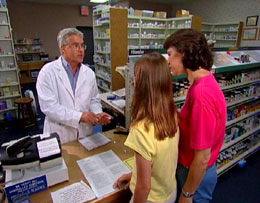 |
 |
 |
 Health & Beauty | July 2005 Health & Beauty | July 2005  
Study: Doctors Limited in Rx Training
 Associated Press Associated Press


| | Study says many doctors, pharmacists acknowledge limited training in prescribing drugs. |
With abuse of prescription drugs growing rapidly, many doctors and pharmacists say they have received limited training in dealing with pain-relievers, stimulants, tranquilizers and other controlled prescription drugs.

One factor behind the growth is that people easily can get these drugs from doctors, friends, relatives and through the Internet, according to a study by the National Center on Addiction and Substance Abuse at Columbia University.

Relying on various government reports, the study cited rapidly rising rates of abuse of prescription drugs, especially among teenagers.

About 15 million people in the U.S. abused controlled prescription drugs and the amount of abuse has gone up sharply over the past decade among all adults and especially among teens, according to the center's analysis of federal data on drug use.

Prescription drug abuse is defined in the study as the taking of prescription drugs not prescribed for the user or use of prescription drugs taken only for the experience or feeling it causes.

"We have an epidemic of abuse of painkillers," said Joseph Califano Jr., the center's chairman and president. "The problem with teens is a far more serious problem than anyone has ever realized."

Many doctors and pharmacists surveyed by the center said they have received only limited training in prescribing drugs.

Four in 10 doctors said they received no training in medical school on prescribing controlled substances; more than one-half received no training on identifying prescription drug abuse or addiction. Three-fourths said they had no training in medical school identifying diversion of prescription drugs for illicit purposes.

Four in 10 pharmacists say they have received no instruction since pharmacy school in dispensing prescription drugs. Almost one-half said they have received no instruction since pharmacy school in identifying prescription drug abuse or diversion of prescription drugs.

The separate polls of 979 physicians and 1,030 pharmacists were conducted during the summer of 2004 and each has a margin of error of plus or minus 3 percentage points.

National Center on Addiction and Substance Abuse http://www.casacolumbia.org | 
 | |
 |



